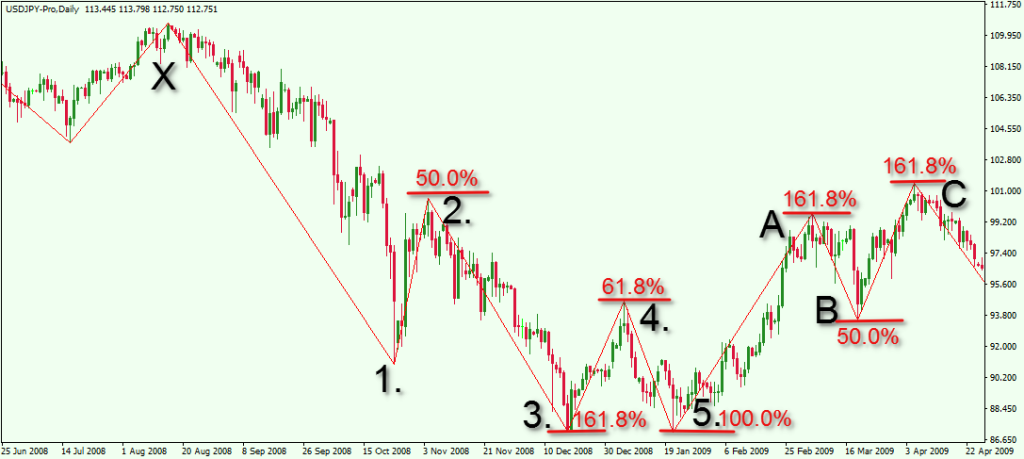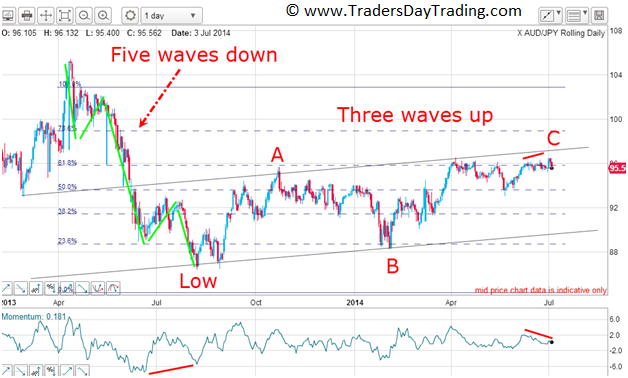Forex trading using fibonacci elliott wave pdf
April 2, Forex Trading Articles. Today we will be covering a more advanced form of technical analysis, referred to as the Elliott Wave Theory. Many traders have heard of the Elliott Wave theory, but some find it a bit overwhelming and complicated. The Elliott Wave concept does have a steeper learning curve than other types of analysis, however, I have found that it is one of the best forecasting tools available to the forex trader. We will dive into the details of this theory and understand how to effectively trade using this technique.
Before we move into the mechanics of the Elliott Wave Theory, we need to review some basics around price action. On every Forex chart there are three basic types of price action phases.
This is the move in the direction of the trend. Usually, trending moves are bigger in terms of price change and take less time. This makes the trending move very attractive to trade. Moves in the direction of the overall trend are referred to as Impulse Waves. The corrective move involves price behavior that is contrary to the impulse move. Corrective moves are smaller in terms of price change and usually they take more time to develop.
This is why they are not as attractive to trade as the impulse moves. If the trend is bullish, then the correction of the trend would be in bearish direction.

If the trend is bearish, then its respective correction would be bullish. In most of the cases consolidations are related with ranging or sideways price moves. However, sometimes corrections could take different forms which illustrate specific chart patterns. These patterns can sometimes help us forecast future price developments. In the early 20th century, an accountant named Ralph Elliott discovered a very important pattern in the markets. He discovered that when the price is trending it creates five legs.
Three of these are impulse waves that move in the direction of the trend and the other two are corrective moves which move counter to the trending move.

He further found that when this trend phase gets exhausted, the price action shifts to a corrective phase, which could be tracked in three moves. So, he concluded that there would be 5 moves that make up the trending phase, and 3 moves that make up the corrective phase. This is known as the Elliott Wave count. Below you will see a sketch of the 5 moves comprising the trend. Ralph Elliott attributed this basic structure in the markets to the behavior of the trading masses.
He outlined the importance of the psychological factors that make up this Elliott Wave structure. As you see, this is the same image with the five trending moves. However, this time we have sketched the potential correction, which appears after the trend.
Notice that move A breaks the trend and typically sets a bottom outside the scope of the trend. Move B then brings the price back to the area of the trend for a resistance test. Move C then forces the price in the direction contrary to the trend.

This is the Elliott Wave sequence. What is important to keep in mind is that the Elliott Wave principle is deeply rooted in mass psychology and this repeatable formation is caused by dynamic changes in the attitudes of the buyers and sellers. The first 5 moves represent the balance of power to the buyers in the case of the bullish market, while the A , B , and C moves represent the balance of power to the sellers in that market.
Though many traders complain that Elliott Wave analysis is too esoteric and difficult to understand with all it rules, the fact is that within the Elliott Wave principle there are only three main unbreakable rules.
Now along with these rules there are some important guidelines as well: The Guideline of Equality says that two impulse waves within a five wave sequence will tend toward equality, and most times this means that when Wave 3 is the extended wave, Wave 1 and Wave 5 will be approximately equal in size. The Guideline of Alternation states that Wave 2 and Wave 4 will alternate. So when Wave 2 is a sharp correction, then we can expect Wave 4 will be a congestive style correction. Also it should be noted that in most cases Wave 2 tends to be Sharp and Wave 4 tends to be congestive.
The Guideline of Corrective Wave Depth — The corrective A, B, C sequence with typically retrace within the territory of the previous Wave 4. The Guideline for Channeling — The use of Elliot Wave parallel trend lines helps to project the potential support and resistance and end points of impulse waves. Firstly, when wave 3 is complete, you could connect the extremes of Wave 1 and 3, then draw a parallel line to the extreme of Wave 2 to find the possible termination of Wave 4.
Forex Click - The Ultimate Free Resource
After Wave 2 and 4 are complete, you would extend a parallel line connecting the extreme of wave 2 and wave 4 to find the end of Wave 5.
The application of Fibonacci ratios are an integral part of Elliot Wave analysis. When price moves to certain percentages, traders tend to have natural inclinations that are played out in the markets. Some of the most important Fibonacci levels include the following: Here are the common relationships that the waves within the Elliot Wave sequence have to Fibonacci levels.
Wave 2 — Wave 3 — Wave A — Wave B — The image below will show you the Fibonacci relationships that confirm Elliott Wave patterns on the chart. Combining The Elliott Wave structure with Fibonacci relationships gives information about high probability turning points and where the next price move will likely terminate. Therefore, counting waves and applying the appropriate Fibonacci levels is essential for every Elliott Wave trader. I will now show you a couple of indicators which can assist with Elliott Wave trading.
Although they are not directly related to Elliott Waves, they can facilitate the wave identification process. Zig Zag Indicator — This is an indicator, which isolates smaller price swings.
The indicator consists of straight lines, which go from crucial tops to crucial bottoms. This helps us to have a clearer picture regarding the important price moves. Fibonacci Retracement — This indicator will plot the Fibonacci ratio levels. You simply stretch the indicator between a low and a high point on the chart and it automatically gives you the retracement levels.
If you combine these two tools, you will begin to simplify your Elliott Wave analysis. On the chart you see the Zig Zag indicator — the thin red lines. The thicker red lines indicate the Fibonacci levels, which are measured by the Fibonacci Retracement indicator.
As you see, the Elliott wave responds accordingly to Fibonacci relationships in a very harmonic manner. The most powerful wave within the Elliott Wave Sequence is Wave 3. This is considered the most attractive wave to trade. In order to identify this wave, we first need a Wave 1 in the direction of a new developing trend followed by a corrective wave, Wave 2, which covers When we identify these two waves, then we can try to anticipate the beginning of Wave 3.
Many times at the beginning of Wave 3 we will also see a Harmonic pattern , usually a Gartley or Bat formation.
Wave 5 also provides a good trading opportunity. Wave 5, will reach anywhere between These are the two impulse Elliott Waves that can be traded. These two waves are formed during the trend phase. We should not forget that the general trending move also creates two corrections. However, corrections are considered harder to trade and provide smaller profit opportunities. After the completion of the trend phase ending with Wave 5, we can anticipate the three A , B , and C waves of the general correction, within the corrective phase, Wave C provides the highest probability trade setup.
Wave C is the most powerful wave within the corrective phase and has many similarities to Impulse Wave 3. I will now show you a trading strategy, where we will attempt to ride some of the waves within the Elliott Sequence. We will also include a standard period Simple Weighted Moving Average , which will help us open and close trades after the price bounces from a Fibonacci level.
In order to open a trade, we will need the price to bounce from a specific Elliott Wave Fibonacci level and then cross the Moving Average in the direction of the move we expect. At the same time, we will stay in each trade as long as the price closes candles above the Moving Average. The image below will show you how this strategy works. This time you also see on the chart a period Simple Moving Average. In Wave 2 the price retraces The price then bounces, closing a candle below the period SMA.
A short signal is generated at About 45 days later Wave 3 reaches a This is when one should carefully keep an eye on the price action for an eventual break in the period SMA. During the exit signal, the price is in the middle of Wave 4, which is a corrective move. The price increase continues to the The period SMA gets broken downwards generating another sell signal at Unfortunately, Move 5 covers only A buy signal comes at This is when a trader should be looking to close a trade.
The price starts a slight consolidation.
sales-wtp — Wavy Tunnel Pro
About 50 days after the buy signal was generated a profitable exit signal was created at There are many different techniques a trader could implement using Elliott waves.
In the above example, we demonstrated the use of Elliott Waves patterns combined with Fibonacci Retracement, Zig Zag Indicator and period Simple Moving Average. My personal preference for trading Elliott Waves is to trade it using a combination of Elliott Wave counts and Fibonacci levels exclusively.
I find that using another technical indicator like the moving average provides for later entries and less profit potential. Newer traders may be more comfortable using the Simple Moving Average or similar to help confirm their Elliott Wave analysis. Also, you should always use a Stop Loss order when you trade Elliott Waves.
The proper location of your stop would be beyond the swing top or bottom which marks the beginning of the wave you trade. Get My Forex Insider Newsletter filled with Exclusive Tips and Strategies.
Download the short printable PDF version summarizing the key points of this lesson…. Click Here to Download. Join My Free Newsletter Packed with Actionable Tips and Strategies To Get Your Trading Profitable….. Click Here to Join.
Get My Forex Insider Newsletter filled with Exclusive Tips and Strategies Get Instant Access. S Trade Balance Economic Report.